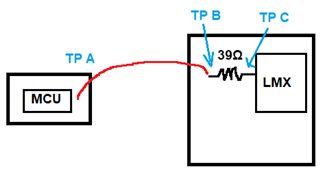Other Parts Discussed in Thread: LMX2595
I am currently trying to interface the LMX2595EVM with a custom control module of my own (created on Digilent's Arty S7-50), and I am currently having trouble communicating with the part and I think I have attributed it to the speed.
What I want to know is why is the performance board talking to the LMX2595EVM at only ~127kHz? Plus, why is there such a long gap between writes (on the order of 12ms)? The datasheet for the part lists the maximum write speed as 75MHz, as well as the minimum enable pulse width high time as 10ns -- I am operating at 50MHz with a high time of 100ns on the enable pulse width
Does anyone know what might be wrong here? Thanks


